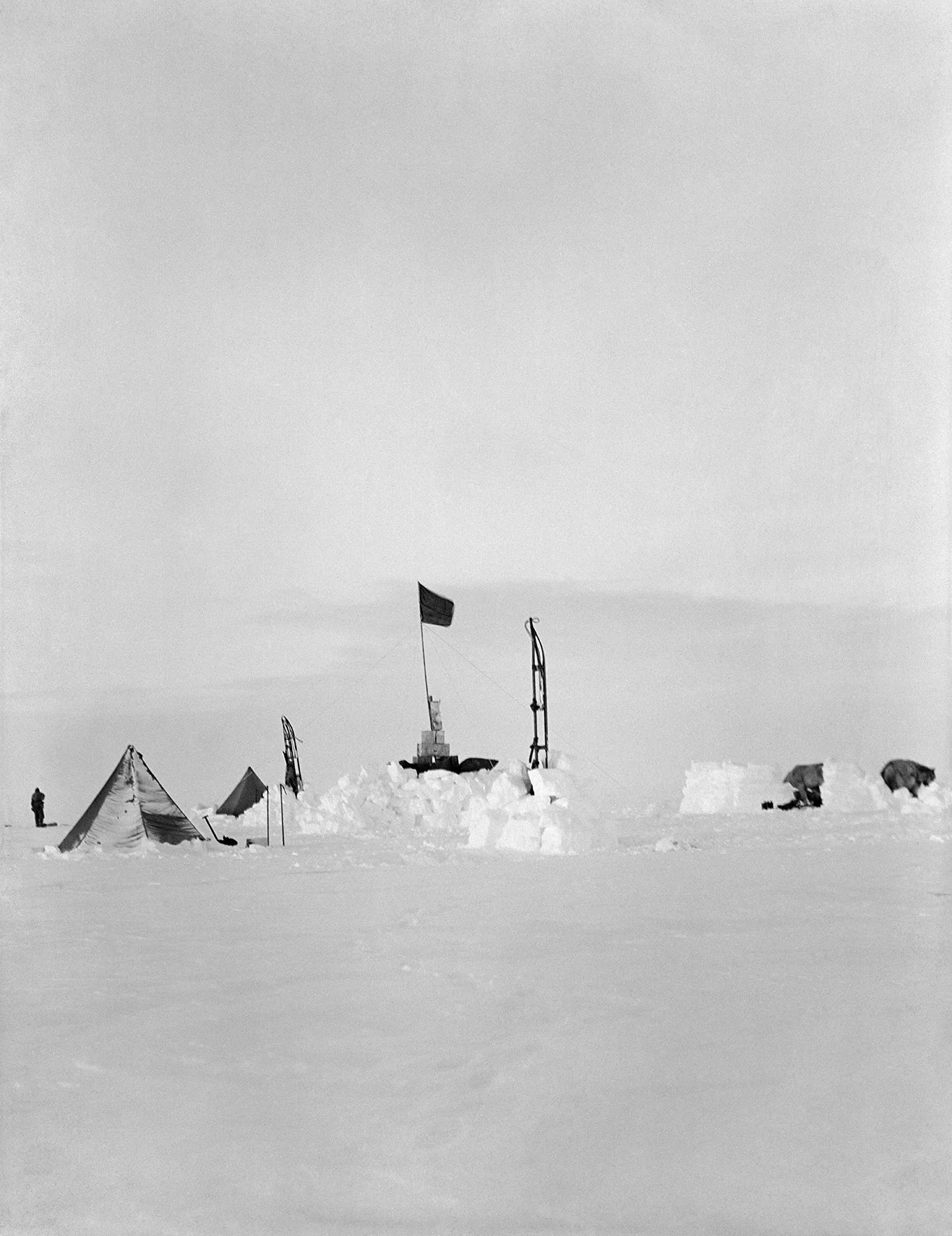CAPTAIN SCOTT'S ANTARCTIC EXPEDITION 1909–1913
The photographs of Captain Scott
Our platinum-palladium prints of Captain Scott’s Terra Nova photographs are produced from the original negatives conserved in the collections of the Scott Polar Research Institute, University of Cambridge.
As they approached the South Pole on the 16th of January 1912, Captain Robert Falcon Scott and his four companions were hoping to find an unbroken horizon of ice no different from the one they had travelled across for weeks and months. What greeted them instead was a black flag planted thirty-four days earlier by Roald Amunden’s Norwegian expedition.
The tragic story of what led to and followed this moment is most famously and poignantly told in Scott own diary. Less well known but equally moving are the photographs that Scott took in the vicinity of Cape Evans while learning photography from Herbert Ponting, and later during his trek south towards the Pole.
Whether individually or as a group, Captain Scott’s photographs are infused with a quiet simplicity that differs from the grand compositions of Ponting. Their unencumbered aesthetics allows them to capture both the vulnerability of the men and their tenacity, the dreariness of the Ice Barrier and the thrill of discovery, the weight of the sledges and the companionship of the ponies.
Rediscovered and acquired by the Scott Polar Research Institute in 2014, Scott’s negatives had previously been known only through a series of postcard-size (10 × 8 cm) contact prints produced in 1935. Through its exclusive collaboration with the Institute, Salto Ulbeek was granted privileged access to the negatives, allowing them to be printed for the first time since 1935 - and this time on a larger scale. The result is a series of platinum-palladium prints of unprecedented quality that not only transport viewers to the very heart of Scott’s Antarctic experience, but also achieve a subtlety and permanence unknown to Scott.
All prints are produced in Salto Ulbeek’s atelier in Belgium. For full details on the availability of edition numbers and sizes, please select the Enquire button and share the title of the print or prints that have you are interested in.
Print Sales
Limited Edition Platinum Palladium Prints. Available in 3 sizes:
SINGLE PRINTS
46.8 x 37.3cm (paper size)
Limited Edition of 15
From 1.600,00 €
PANORAMIC PRINTS
75.5 x 46.5cm (paper size)
From 2.400,00 €
PANORAMIC PRINTS
113 x 65.5cm (paper size)
From 3.100,00 €
Prints are stamped by Artist’s Estate and include a certificate of authenticity.
© Scott Polar Research Institute, University of Cambridge
© Salto-Ulbeek
Camp on the Ferrar Glacier: Mt Sister, the Overflow Glacier, the Royal Society Range, Descent Glacier and Cathedral Rocks. Spring Journey sequence, September 1911.
Ref. Pano S3-S4
ENQUIRE
View from the Sea Ice: Blue Glacier to Cape Roberts. Spring Journey sequence. 25 September 1911
Ref. Pano S29-S2-S9-S10
ENQUIRE
Herbert Ponting working at Cape Evans, Cinematograph 5. Ponting Exposure experiments. Down stop 78.7, September 1911
Ref. Image S13
ENQUIRE
Looking up The Gateway to Mount Hope, from Camp 31, Shambles Camp. Pole Journey, Great Ice Barrier. 9 December 1911
Ref. Pano S49-S50
ENQUIRE
Dr. Edward Wilson sketching, Mount Elizabeth to Mount Fox, Pole Journey, Beardmore Glacier, lunch camp. 13 December 1911
Ref. Pano S33-S32
ENQUIRE
Foundering in soft snow: Bowers sledge, Wilson pushing; Oates and PO Evans repairing, Pole Journey: Beardmore Glacier, 13 December 1911, Lunch camp
Ref. Image S71
ENQUIRE
Foundering in soft snow: probably Keohane and Crean waiting to depart, Pole Journey: Beardmore Glacier, 13 December 1911, Lunch camp
Ref. Image S67
ENQUIRE
Foundering in soft snow: Pulling: (l-r) Cherry-Garrard; Bowers; Keohane; and Crean. Pushing: Captain Scott (front) and Dr. Wilson (behind), Pole Journey: Beardmore Glacier, 13 December 1911, Lunch camp
Ref. Image S121
ENQUIRE
Foundering in soft snow: (l-r) Cherry-Garrard, Bowers, Keohane and Crean, Pole Journey: Beardmore Glacier, 13 December 1911, Lunch camp
Ref. Image S70
ENQUIRE
Whether individually or as a group, Captain Scott’s photographs carry us back to the heart of the Heroic Age of Antarctic exploration. They also transport us far inland into regions beyond the reach of Ponting, whose fitness and cumbersome equipment prevented him from taking part in longer sledging journeys. Scott’s photographs and panoramic images are infused with a quiet simplicity and contemplation that differs from the grand compositions of his photographic master, Ponting. Their unencumbered aesthetics allows them to capture both the vulnerability of the men and their tenacity, the dreariness of the Ice Barrier and the thrill of discovery, the weight of the sledges and the companionship of the ponies.
The photographs also provide clues as to the environmental, logistical and human circumstances that allowed the expedition’s successes, but also led to its tragic failures. In contrast to the assurance of Captain Scott’s writing in forging a historical narrative, his photographs speak of the doubts and improvisations of a man learning a craft whilst leading an uncertain enterprise. Rather than any hint of heroism, what they convey with a certain melancholy is the singular predicament of a group of explorers immersed in an environment that is as hostile as it is otherworldly.


